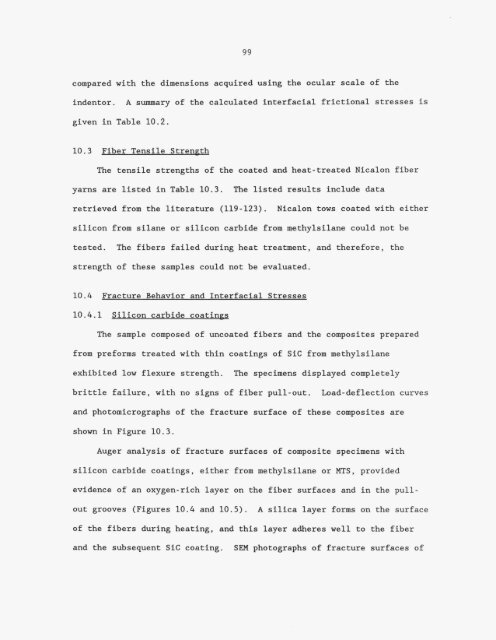Characterization and control of the fiber-matrix interface in ceramic ...
Characterization and control of the fiber-matrix interface in ceramic ...
Characterization and control of the fiber-matrix interface in ceramic ...
Create successful ePaper yourself
Turn your PDF publications into a flip-book with our unique Google optimized e-Paper software.
99<br />
compared with <strong>the</strong> dimensions acquired us<strong>in</strong>g <strong>the</strong> ocular scale <strong>of</strong> <strong>the</strong><br />
<strong>in</strong>dentor.<br />
A summary <strong>of</strong> <strong>the</strong> calculated <strong>in</strong>terfacial frictional stresses is<br />
given <strong>in</strong> Table 10.2.<br />
10.3 Fib er Tensile Streneth<br />
The tensile strengths <strong>of</strong> <strong>the</strong> coated <strong>and</strong> heat-treated Nicalon <strong>fiber</strong><br />
yarns are listed <strong>in</strong> Table 10.3.<br />
The listed results <strong>in</strong>clude data<br />
retrieved from <strong>the</strong> literature (119-123). Nicalon tows coated with ei<strong>the</strong>r<br />
silicon from silane or silicon carbide from methylsilane could not be<br />
tested. The <strong>fiber</strong>s failed dur<strong>in</strong>g heat treatment, <strong>and</strong> <strong>the</strong>refore, <strong>the</strong><br />
strength <strong>of</strong> <strong>the</strong>se samples could not be evaluated.<br />
10.4 Fracture Behavior <strong>and</strong> Interf acial Stresses<br />
10.4.1 Silicon carbide coat<strong>in</strong>a<br />
The sample composed <strong>of</strong> uncoated <strong>fiber</strong>s <strong>and</strong> <strong>the</strong> composites prepared<br />
from preforms treated with th<strong>in</strong> coat<strong>in</strong>gs <strong>of</strong> SIC from methylsilane<br />
exhibited low flexure strength.<br />
The specimens displayed completely<br />
brittle failure, with no signs <strong>of</strong> <strong>fiber</strong> pull-out. Load-deflection curves<br />
<strong>and</strong> photomicrographs <strong>of</strong> <strong>the</strong> fracture surface <strong>of</strong> <strong>the</strong>se composites are<br />
shown <strong>in</strong> Figure 10.3.<br />
Auger analysis <strong>of</strong> fracture surfaces <strong>of</strong> composite specimens with<br />
silicon carbide coat<strong>in</strong>gs, ei<strong>the</strong>r from methylsilane or MTS, provided<br />
evidence <strong>of</strong> an oxygen-rich layer on <strong>the</strong> <strong>fiber</strong> surfaces <strong>and</strong> <strong>in</strong> <strong>the</strong> pull-<br />
out grooves (Figures 10.4 <strong>and</strong> 10.5).<br />
A silica layer forms on <strong>the</strong> surface<br />
<strong>of</strong> <strong>the</strong> <strong>fiber</strong>s dur<strong>in</strong>g heat<strong>in</strong>g, <strong>and</strong> this layer adheres well to <strong>the</strong> <strong>fiber</strong><br />
<strong>and</strong> <strong>the</strong> subsequent Sic coat<strong>in</strong>g.<br />
SEM photographs <strong>of</strong> fracture surfaces <strong>of</strong>

















